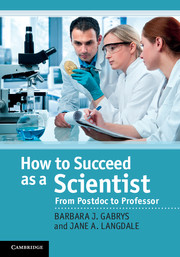Part I - Becoming an independent researcher
Published online by Cambridge University Press: 05 November 2011
Summary
Becoming an independent researcher
You have to learn the rules of the game. And then you have to play better than anyone else.
Albert EinsteinIn the first part of this book we look at the skills needed to make the transition from being a postdoc working with a principal investigator (PI) to becoming an independent research scientist. Successful careers in the sciences are normally built on good time management skills and so in the first chapter we explore how to manage your time and look at the different roles you have to play in academia. We then turn our attention to the task of communicating your research both verbally (Chapter 2) and in writing (Chapter 3). In both cases you need to be able to handle any subsequent criticism and we address how to do this in Chapter 4. We then move on to grant writing in Chapter 5. Convincing others that you and your science are worth funding is an essential skill to learn. Similarly, you must be able to manage the project to successful completion once it is funded, and so we look at tools for managing research projects in Chapter 6. Finally we close this section with three chapters that look at the ‘next step’. Chapter 7 looks at alternative careers in science, Chapter 8 analyses the art of applying for an academic job and preparing for the interview, and Chapter 9 extends this analysis to applications for independent research fellowships.
- Type
- Chapter
- Information
- How to Succeed as a ScientistFrom Postdoc to Professor, pp. 1 - 2Publisher: Cambridge University PressPrint publication year: 2011



